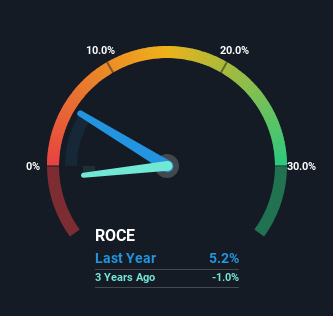- Singapore
- /
- Semiconductors
- /
- SGX:BXE
These Return Metrics Don't Make CDW Holding (SGX:BXE) Look Too Strong
If you're looking at a mature business that's past the growth phase, what are some of the underlying trends that pop up? When we see a declining return on capital employed (ROCE) in conjunction with a declining base of capital employed, that's often how a mature business shows signs of aging. This indicates the company is producing less profit from its investments and its total assets are decreasing. Having said that, after a brief look, CDW Holding (SGX:BXE) we aren't filled with optimism, but let's investigate further.
What Is Return On Capital Employed (ROCE)?
For those that aren't sure what ROCE is, it measures the amount of pre-tax profits a company can generate from the capital employed in its business. To calculate this metric for CDW Holding, this is the formula:
Return on Capital Employed = Earnings Before Interest and Tax (EBIT) ÷ (Total Assets - Current Liabilities)
0.052 = US$3.3m ÷ (US$118m - US$54m) (Based on the trailing twelve months to December 2022).
Thus, CDW Holding has an ROCE of 5.2%. Ultimately, that's a low return and it under-performs the Semiconductor industry average of 19%.
Check out our latest analysis for CDW Holding

Historical performance is a great place to start when researching a stock so above you can see the gauge for CDW Holding's ROCE against it's prior returns. If you'd like to look at how CDW Holding has performed in the past in other metrics, you can view this free graph of past earnings, revenue and cash flow.
What Can We Tell From CDW Holding's ROCE Trend?
We are a bit worried about the trend of returns on capital at CDW Holding. Unfortunately the returns on capital have diminished from the 7.5% that they were earning five years ago. On top of that, it's worth noting that the amount of capital employed within the business has remained relatively steady. Since returns are falling and the business has the same amount of assets employed, this can suggest it's a mature business that hasn't had much growth in the last five years. If these trends continue, we wouldn't expect CDW Holding to turn into a multi-bagger.
While on the subject, we noticed that the ratio of current liabilities to total assets has risen to 46%, which has impacted the ROCE. If current liabilities hadn't increased as much as they did, the ROCE could actually be even lower. And with current liabilities at these levels, suppliers or short-term creditors are effectively funding a large part of the business, which can introduce some risks.
Our Take On CDW Holding's ROCE
In summary, it's unfortunate that CDW Holding is generating lower returns from the same amount of capital. Despite the concerning underlying trends, the stock has actually gained 35% over the last five years, so it might be that the investors are expecting the trends to reverse. Either way, we aren't huge fans of the current trends and so with that we think you might find better investments elsewhere.
One final note, you should learn about the 4 warning signs we've spotted with CDW Holding (including 2 which are significant) .
If you want to search for solid companies with great earnings, check out this free list of companies with good balance sheets and impressive returns on equity.
The New Payments ETF Is Live on NASDAQ:
Money is moving to real-time rails, and a newly listed ETF now gives investors direct exposure. Fast settlement. Institutional custody. Simple access.
Explore how this launch could reshape portfolios
Sponsored ContentNew: AI Stock Screener & Alerts
Our new AI Stock Screener scans the market every day to uncover opportunities.
• Dividend Powerhouses (3%+ Yield)
• Undervalued Small Caps with Insider Buying
• High growth Tech and AI Companies
Or build your own from over 50 metrics.
Have feedback on this article? Concerned about the content? Get in touch with us directly. Alternatively, email editorial-team (at) simplywallst.com.
This article by Simply Wall St is general in nature. We provide commentary based on historical data and analyst forecasts only using an unbiased methodology and our articles are not intended to be financial advice. It does not constitute a recommendation to buy or sell any stock, and does not take account of your objectives, or your financial situation. We aim to bring you long-term focused analysis driven by fundamental data. Note that our analysis may not factor in the latest price-sensitive company announcements or qualitative material. Simply Wall St has no position in any stocks mentioned.
About SGX:BXE
CDW Holding
An investment holding company, produces and supplies precision components in Mainland China, Hong Kong, Japan, and internationally.
Excellent balance sheet second-rate dividend payer.
Market Insights
Weekly Picks

THE KINGDOM OF BROWN GOODS: WHY MGPI IS BEING CRUSHED BY INVENTORY & PRIMED FOR RESURRECTION


Why Vertical Aerospace (NYSE: EVTL) is Worth Possibly Over 13x its Current Price


The Quiet Giant That Became AI’s Power Grid
Recently Updated Narratives


Unicycive Therapeutics (Nasdaq: UNCY) – Preparing for a Second Shot at Bringing a New Kidney Treatment to Market (TEST)

Rocket Lab USA Will Ignite a 30% Revenue Growth Journey


Dollar general to grow
Popular Narratives


MicroVision will explode future revenue by 380.37% with a vision towards success


NVDA: Expanding AI Demand Will Drive Major Data Center Investments Through 2026


Crazy Undervalued 42 Baggers Silver Play (Active & Running Mine)
Trending Discussion




